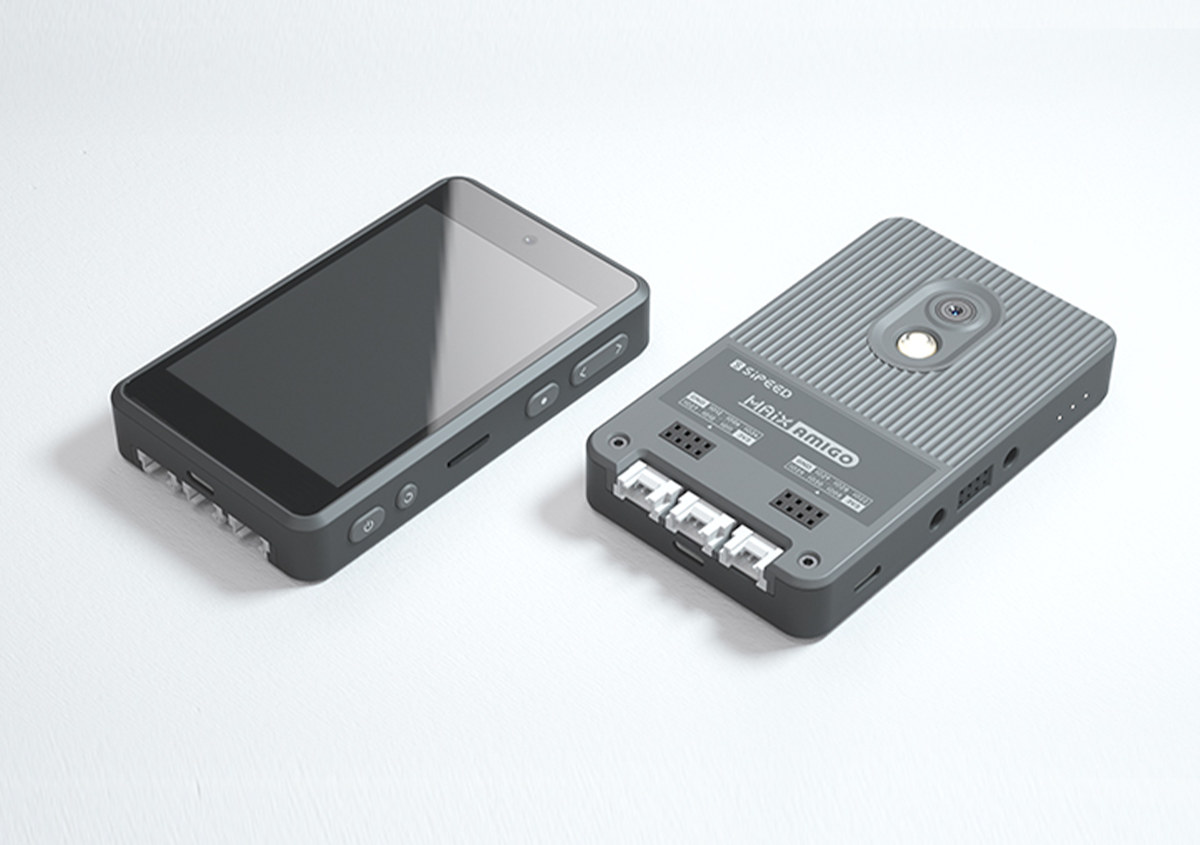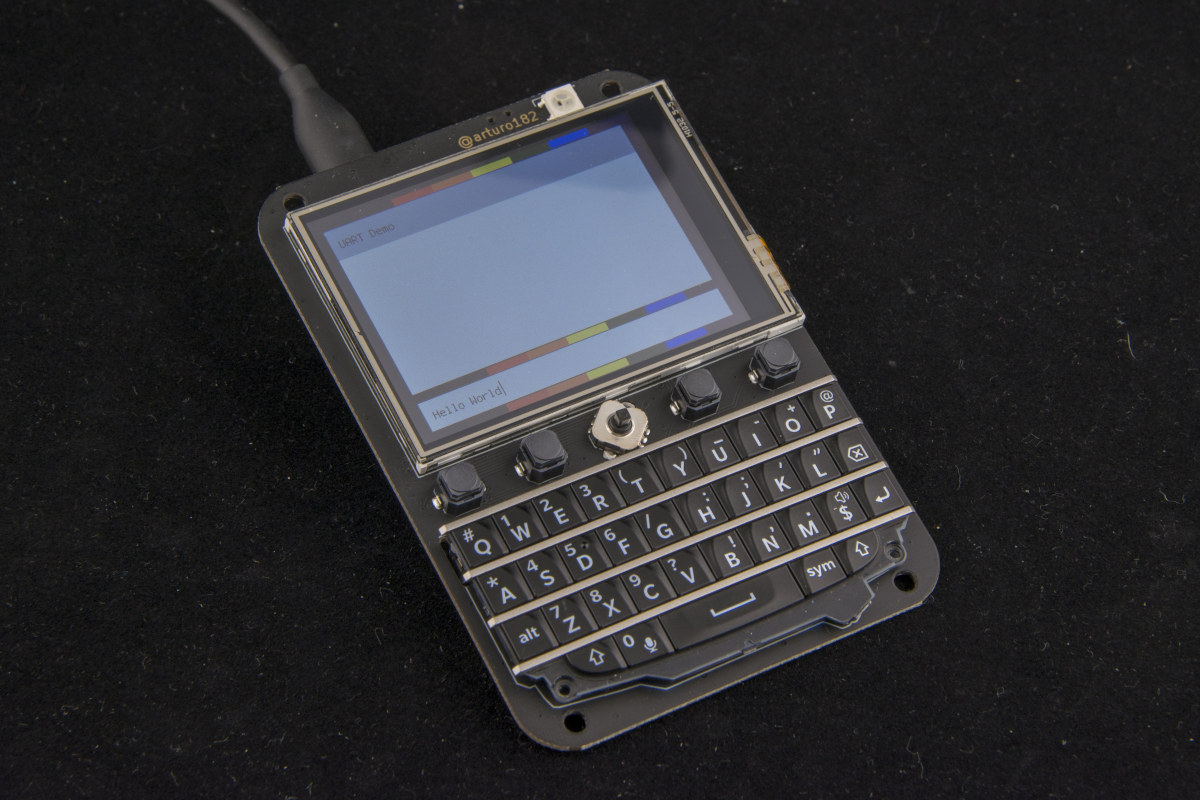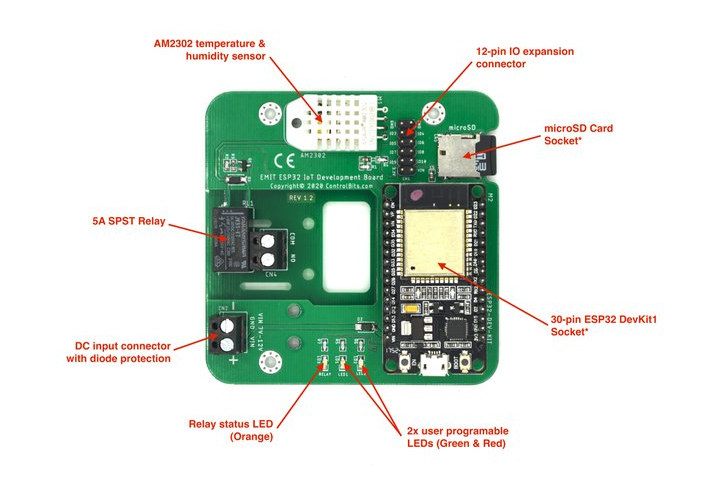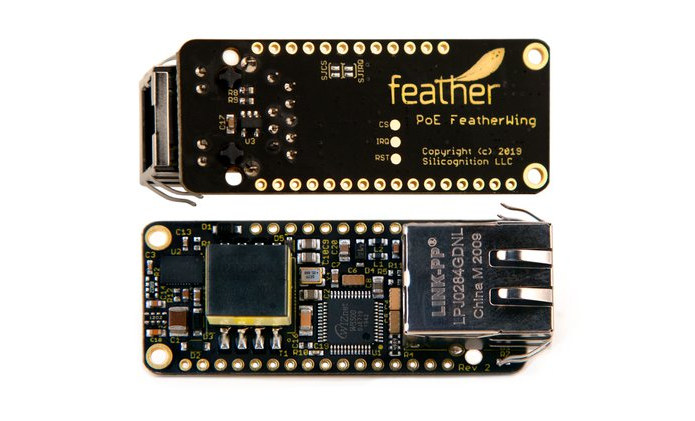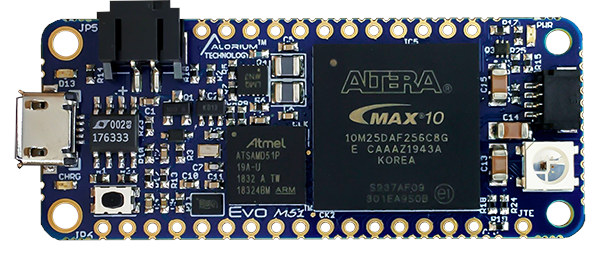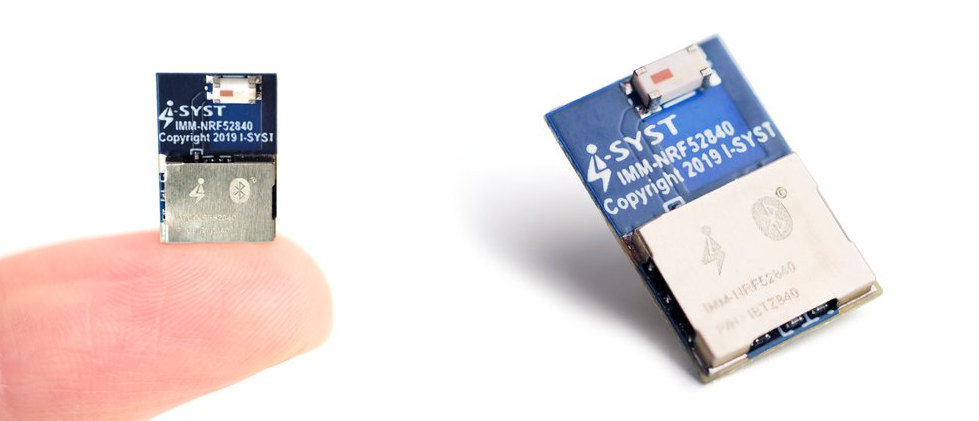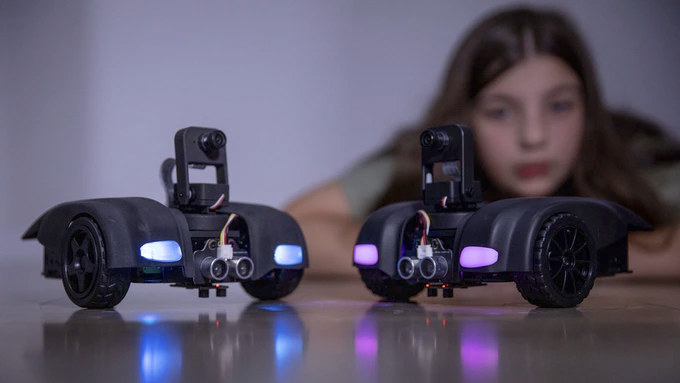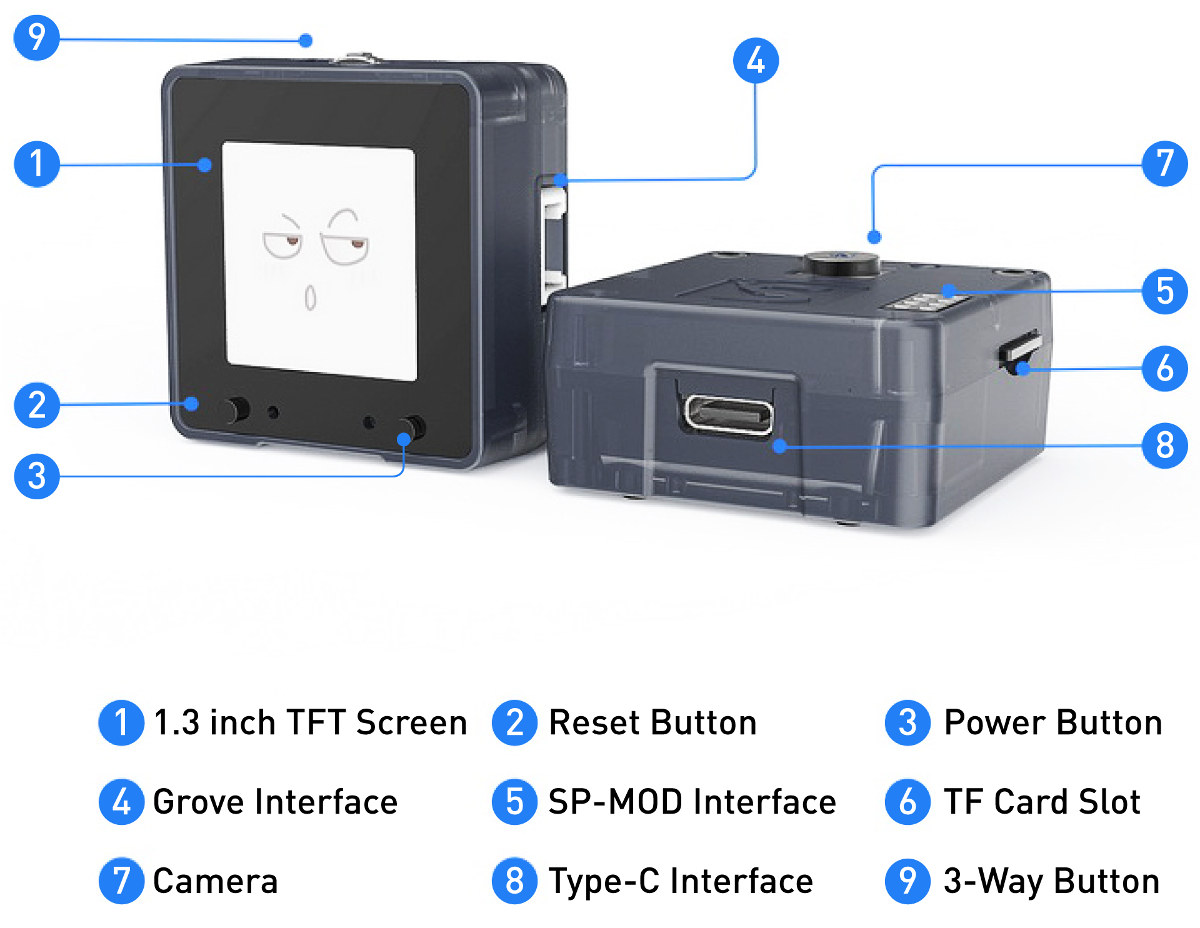Earlier this year, Seeed Studio introduced Wio Terminal a portable Arduino devkit with an LCD display, and expansion connectors and headers. The company is now selling a similar looking devkit but for different applications with Sipeed Maix Amigo portable 64-bit RISC-V development kit powered by Kendryte K210 RISC-V AI processor and equipped with an LCD display, two cameras, a few buttons, and several I/O headers and Grove connectors. Sipeed Maix Amigo specifications: SoC – Kendryte K210 Dual-core 64-bit RISC-V (RV64GC) processor with FPU @ 400 MHz (overclockable to 500MHz), 8MB SRAM, built-in AI accelerators for video and audio Storage – 16MB Flash, MicroSD card slot up Display – 3.5-inch TFT capacitive touch screen display with 480×320 resolution Camera VGA front-facing camera up to 30 fps (GC0328 sensor) VGA rear camera up to 60 fps (OV7740 sensor) Audio – Build-in microphone, optional 6-mic array USB – 1x USB Type-C port for […]
Keyboard FeatherWing Brings Keyboard & Display to Adafruit Feather Boards
Solder Party is a brand new Swedish startup founded by Arturo182 who previously designed several maker boards including the tiny Serpente R2 CircuitPython prototyping board, and its first product, named Keyboard FeatherWing, brings a QWERTY keyboard and 2.6” color LCD with resistive touch screen to any boards compatible with Adafruit Feather for factor. That means you can build a portable device that runs Linux via the Giant Board, features an FPGA (Orange Crab), or a wide range of connectivity options including WiFi, Bluetooth LE, LoRa, etc… depending on your chosen board. The solution actually brings a bit more than just a keyboard and color, as shown by the list of Keyboard FeatherWing key features: Display – 2.6” 320×240 16-bit color LCD with resistive touch screen (SPI) Storage – MicroSD card slot (SPI) User Inputs controlled by a Microchip SAMD20 MCU QWERTY keyboard (I2C) 5-way button 4 soft tactile buttons Expansion […]
EMIT ESP32 IoT Development Board Comes with Temperature & Humidity Sensor, 5A SPST Relay (Crowdfunding)
ControlBits EMIT (Environmental Monitoring for the Internet of Things) is a baseboard compatible with DOIT ESP32 DevKit V1 development board and equipped with a temperature and humidity sensor, a relay, a 12-pinGPIO connector, and a MicroSD card. EMIT ESP32 IoT development board specifications: Socket for DOIT ESP32 DevKit v1 board with WiFi and Bluetooth LE connectivity Storage – MicroSD card socket Sensor – AM2302 temperature & humidity sensor with -40° to +80° C and 0 to 99.9 %RH ranges. Relay – 5A SPST relay output with status LED Expansion – 12-pin GPIO header Misc – 2x programmable status LEDs (red & green) Power Supply – 5V via USB on ESP32 board, or external 7-12 V supply via terminal block Dimensions – 81 x 81 mm (PCB only) The board comes with mounting holes so it can be wall-mounted, and an optional enclosure is also available. Some applications for the board […]
PoE FeatherWing Brings PoE, Unique MAC Address to Adafruit Feather Boards (Crowdfunding)
[Update: In the initial version of this post, Giant Board was wrongly attributed to Silicognition LLC (Patrick Van Oosterwijck). It was actually made by Groguard] Silicognition LLC (Patrick Van Oosterwijck)’s PoE FeatherWing is an expansion board that adds PoE support to Adafruit Feather boards and can handle up to 4 Watts of power. The expansion board also comes with a built-in globally unique MAC address. It’s similar to the official Ethernet FeatherWing, but with the addition of PoE and a unique MAC address. PoE FeatherWing key hardware features and specifications: WIZnet W5500 Ethernet controller up to ~13 Mbps Microchip 24AA02E48 2 Kbit serial EEPROM with built-in globally unique MAC address to avoid having to change and recompile the code for each device. Power Isolated IEEE 802.3at Class 1, Mode A and Mode B Power over Ethernet (PoE) with up to 4W of output power available via an RJ45 Ethernet port […]
Feather-Sized Evo M51 Board Combines Atmel SAMD51 MCU with Intel MAX 10 FPGA
Arduino unveiled its first FPGA board around two years ago with MKR Vidor 4000 combining an Intel Cyclone FPGA with Microchip SAMD21 Cortex-M0+ MCU in a form factor similar to Arduino Zero. But in case you are looking for an even smaller Arduino compatible FPGA board, Alorium Technology’s Evo M51 might be exactly what you are after. The Adafruit Feather-sized board is equipped with an Atmel SAMD51 Arm Cortex-M4F microcontroller coupled with an Intel MAX 10 FPGA. Evo M51 specifications: MCU – Microchip (Atmel) SAMD51 Arm Cortex-M4F microcontroller clocked at 120 MHz with 512KB flash, 192 KB SRAM FPGA – Intel MAX 10 (10M25) FPGA with 25K LEs, 675Kbit block memory Storage – 2MB external flash USB – 1x micro USB port for power and programming I/O Digital 55x Total Digital I/O – 21x through-hole/castellated vias, 34x additional castellated-only 6x digital pins shared with analog pins 3.3V Inputs, 3.3V Outputs […]
Fingernail-sized BLYST840 nRF52840 Module Features Bluetooth 5.2, Thread, Zigbee and 46 I/O (Crowdfunding)
Canada based I-SYST inc has designed a tiny nRF52840 module about the size of a fingernail. BLYST840 module fully leverages the capability of Nordic Semi’s wireless microcontroller with Bluetooth 5.2, Thread, and Zigbee connectivity, and exposes 46 I/Os. BLYST840 specifications: Wireless MCU – Nordic Semiconductor nRF52840 Arm Cortex-M4F microcontroller @ 64 MHz with 1 MB flash, 256 KB RAM Connectivity Bluetooth 5.2 up to 2 Mbps, -96 dBm sensitivity for long-range; Up to 111 dB link budget; Bluetooth Mesh IEEE 802.15.4 radio support for Thread & Zigbee NFC-A Built-in ceramic antenna Output power – Adjustable from +8 dBm to -20 dBm 46 I/O pins exposed via pads around the edges of the module including QSPI/SPI/2-wire/I2S/PDM/QDEC Programmable Peripheral Interface (PPI) SPI interface @ 32 MHz Quad SPI interface @ 32 MHz EasyDMA for all digital interfaces USB 2.0 (12 Mbits) 12-bit/200K SPS ADC Security Arm TrustZone Cryptocell 310 128-bit AES/ECB/CCM/AAR co-processor […]
MARK AI Robot Kit Aims to Teach AI & Robotics to 12+ Years Old (Crowdfunding)
We’ve written about Kendryte K210 RISC-V AI processor, and Sipeed M1 module several times including in our getting started for Maixduino and GroveAI HAT boards for low-power AI inference such as object recognition or face detection using Arduino and Micropython programming. Shenzhen-based Tinkergen, a STEM Education owned by Seeed Studio, has now leveraged the low-cost processor to design MARK AI robot kit, where MARK stands for Make A Robot Kit, in order to processor an educational AI Robotics platform for children ages 12 years old and more. MARK will ship as a kit with the main parts and components including a chassis, a cover, two wheels, stepper motors, a pan-tilt camera with K210 processor, a 2.4″ LCD display, Grove & Arduino compatible MARKduino interface board, some sensors, and six AA batteries. Tinkergen offers pre-trained model to recognized objects like humans, books, pens, or smartphones, as well as traffic signs, numbers […]
Sipeed MaixCube is a Fully Integrated AI Development Platform Powered by Kendryte K210 RISC-V SoC
Sipeed has made several boards and kits based on Kendryte K210 RISC-V processor for low-power AI workloads such as face detection or object recognition including Maixduino board and Grove AI HAT that ship with camera and display. The company has now come up with MaixCube all-in-one development platform that houses Sipeed M1 module, a display, a camera, and a battery into a plastic case that’s somewhat similar to MStack M5StickV but with a larger display, and variations in the form factor and features. Sipeed MaixCube specifications: SoC – Kendryte K210 dual-core 64-bit RISC-V processor @ 400 MHz (overclockable to 600 MHz) with FPU, 8MB SRAM, KPU AI accelerator, APU audio processor, and FFT accelerator Storage – 128 Mbit flash, MicroSD card slot Display – 1.3″ TFT screen with 240×240 resolution Camera – OV7740 sensor (VGA camera) Audio – Built-in microphone, external speakers support; ES8374 audio codec USB – 1x USB […]


